Secrets of a Forgotten War
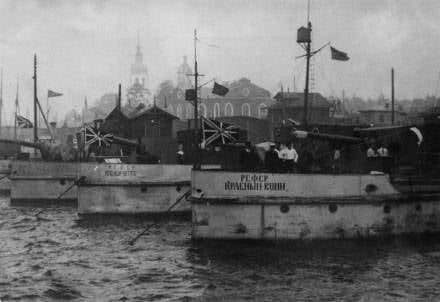 Little is written about the Civil War. However, the experience of the actions of the Soviet and British fleets on the Northern Dvina has not lost its relevance.
Little is written about the Civil War. However, the experience of the actions of the Soviet and British fleets on the Northern Dvina has not lost its relevance.Northern Dvina served as the main transport artery of Russia since the time of Lord Novgorod the Great.
There were no railways and highways in the basin of the Northern Dvina, and there were very few horse-drawn roads, so the river was the main and practically the only way in the region. In 1906, on the Northern Dvina, 239 steam vessels and non-steam 1507 sailed. The data on 1918 could not be found, but we can safely increase these figures by one and a half times.
The main types of vessels sailing along the river are small towboats with a length of 36 – 58 m.
There were also American-style passenger ships up to 76 m, with two-tiered superstructures, on the Northern Dvina. One of them, “Gogol”, still carries tourists along the Northern Dvina.
Already in the spring of 1918, warships from England, France and the United States came with artillery regiments of marines to Arkhangelsk and Murmansk, ostensibly to protect military supplies in these ports from German and White Finns invasion.
Of course, there was no smoke without fire. Indeed, at the end of April 1918, a large detachment of white Finns on skis moved to the port of Pechenga. At the request of the Murmansk Council of Workers 'and Soldiers' Deputies, the English admiral Kemp ordered to put a detachment of Russian Red Guards on the cruiser Cochran.
May 3 "Cochrane" arrived in Pechenga, where he landed the Red Guards. To help them, the captain of the cruiser Farm sent a detachment of British sailors under the command of Captain 2 of the rank of Scott.
The first attack on the Pechenga was made by the Finns on May 10. The main forces of the Finns attacked the allies of 12 in May. However, by joint efforts, the English sailors and Red Guards (most of them were sailors from the cruiser “Askold”) managed to disperse and drive away the Finns.
Cooperation between the Soviets and the Entente in the North did not last long. As a result, in August, 1918 was a peaceful way, and where, after small skirmishes, the power in the North passed into the hands of the opponents of the Soviet government, supported by the British.
2 August 1918 was created in Arkhangelsk, the Supreme Directorate of the Northern Region. The government was a coalition of Socialist-Revolutionaries, Popular Socialists and Cadets. Its chairman was the populist known from the 70-ies of the XIX century, and from the 1904 the Social Revolutionary I. IV Tchaikovsky (1850 – 1926). By the way, after the defeat of the Tchaikovsky revolutionary organization, Tchaikovsky emigrated to England in 1874 and only in 1906 did he return to Russia. 28 September this government was disbanded and received the name "Provisional Government of the Northern Region" led by the same Tchaikovsky.
In the autumn of 1918, the Allies landed two British infantry brigades, a regiment of the American infantry and a French battalion in Arkhangelsk.
The British began the formation of the Slavic-British Legion and the Murmansk Volunteer Army, but managed to recruit no more than 4,5 thousand people, mostly officers of the former Tsarist army.
As early as August 2, 1918, the Bolsheviks and part of the former sailors flotilla The Arctic Ocean removed from Arkhangelsk most of the river ships (up to 50 pennants). Passing through settlements on the river (Kholmogory, Emetskoye, Dvinsky Bereznik), the Bolsheviks took with them all the steamers and barges that stood there.
At the mouth of the river Vaga, one tugboat armed with three machine guns and an 22 team man were left. All the other 5 ships of August in 11 hours of the morning came to the city of Kotlas, located in 625 versts from Arkhangelsk.
In Kotlas, under the leadership of the former deputy head of the Arkhangelsk regional executive committee Pavlin Vinogradov, the creation of a red Severodvinsk flotilla began. Initially (6 – 7 of August) three ships were armed.
In turn, the British realized the strategic importance of the Northern Dvina. It was along Northern Dvina that the interventionists planned to reach Kotlas. The railway was not there. Well, in Kotlas there was a railway going to Vyatka and further to the Urals. In Kotlas, the British intended to connect with the troops of Kolchak, and then along Sukhona to reach Vologda. For this, of course, needed a powerful river fleet.
In Arkhangelsk, several 12-pounder (76-mm) guns were removed from the British cruiser "Attentive", and they armed the steamships "Advokat" and "Gorodok" (one gun for each). In addition, three 12-pound cannons were armed with a non-self-propelled barge, and two Fayri float seaplanes were raised to its deck.
10 August the gunboats "Lawyer" and "Town", taking a barge in tow, left Arkhangelsk up the Dvina.
On August 7, the ships of the red detachment under the command of Pavlin Vinogradov left Kotlas and headed down towards the allied squad.
At Bereznik, at the mouth of the river Vaga, the first battle took place.
The commander of the Northeastern District, M. S. Kedrov, telegraphed Lenin joyfully: “Our detachment of ships under the command of Comrade Chairman of the Arkhangelsk Provincial Executive Committee Pavlin Vinogradov met with superior enemy forces at the mouth of the Vaga and defeated the enemy. Of the five enemy ships, the ship "Zarya" was taken by us in captivity with all the supplies and cargoes and four machine guns. "
The leader himself wrote on the telegram: “To press. A major victory over the British and the White Guard scum. "
In fact, the steamer Zarya, which was thrown onto the shore, was discovered red before the battle in 15 km from the mouth of the Vaga. Losses in the ship composition of the Allies was not. There were several wounded, including Major Ringui.
On August 12, the lawyers “Advokat” and “Gorodok” with a barge with seaplanes approached the Allied ships near the village of Bereznik. The Allies moved up the Dvina without encountering resistance. The Fae aircraft, which took off for reconnaissance, did not detect enemy ships. So Peacock Vinogradov and Cedar "big" cheated Comrade Lenin.
In late August - early September, the British armed two more ships in Arkhangelsk - Spill (two 12-pound cannons) and Experience (three Skoda 77-mm cannons and one 120-mm howitzer). Four powerboats armed 37-mm and 40-mm automatic guns and machine guns.
By this time, two monitors came from England to Arkhangelsk: the M-23 and the M-25.
28 August monitor M-25 went upriver to explore and came under heavy shelling. The monitor had almost no projectiles, since most of the battle stock was brought ashore to reduce the draft. Nevertheless, he managed to silence the battery of reds, losing four people killed and seven wounded.
Monitors did not obey the steering wheel very well, it was generally not an easy task to control them, and M-25 was no exception in this regard. To control the monitor on the rapid course of the Dvina, covered with islets and shoals, moreover, it was extremely difficult in the thick fog. Early in the morning of September 14, not reaching two miles to Chamovo, from the flotilla saw a cannoner of the Reds Mighty standing at the shore. They also noticed the enemy on Moguchem, immediately let out moorings, and the ship began to leave quickly, having an advantage in the course over the vessels of the allied flotilla. However, two hits of 83-mm projectiles fired from the M-25 monitor made the “Mighty” stop. He began to sink, the team jumped overboard. 18 people of the Mighty team were killed, seven were raised from the water by the allies, and five managed to reach the shore and escape.
At the beginning of September, the Reds stationed artillery and infantry cover at Chamovo, commanded the ambush by Peacock Vinogradov himself. The first clashes took place before the start of the Allied general offensive. September 8 seemed four allied ship. The red battery opened fire, the allies immediately responded. One of the first shells were killed Peacock Vinogradov and Red Army man Fomichev. Reds retreated.
After the battle at Chamovo, the allies moved further upstream.
The Bolsheviks from Petrograd continuously sent sailors and armaments to Kotlas. On 10 September, 200 min arr was delivered to Kotlas. 1908. 15 of September: sea instruments arrived at Kotlas by rail: two 120 / 45-mm, four 102 / 60-mm, five 75 / 50-mm and one 40-mm Vickers anti-aircraft gun.
Began arming ships flotilla.
The gunboat "Murman" (from 22 September 1918, the "Peacock Vinogradov") was built in 1906 in Kolomna. Length 59,13 m, width 8,23 / 17,1 m, draft 1,24 m. Machine compound capacity 540 l. with. 10 speed nodes.
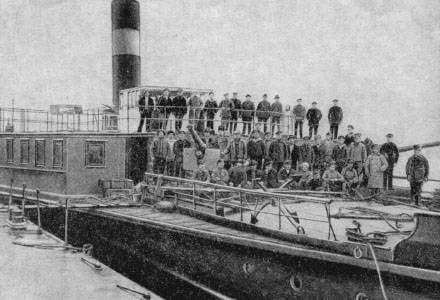 The crew of the gunboat "Peacock Vinogradov"
The crew of the gunboat "Peacock Vinogradov"Gunboat "Kakston", built in 1905 in England. Length 39,62 m, width 5,73 / 10,4 m, draft 1,52 m. Machine compound capacity 360 l. with. 9 speed nodes. Armament: two 75 / 50-mm cannons and two machine guns.
In addition, two iron barges with a payload in 5000 poods were turned into floating batteries and armed with two 102 / 60-mm guns each.
On September 3, three M-9 seaplanes arrived in Kotlas, forming a naval squadron.
By November 11, the 3 th detachment (three M-9), the White Sea detachment (three M-9) and the fighter squadron (three types of Dux and four types of Newport) arrived in Kotlas.
September 16 monitor, supported by the fire of the British infantry, defending Chamovo, found and sank the red gunboat. In fact, it was the ship "Grandfather", carrying weapon and food for the red parts.
Then the flotilla of the Allies went upstream, and suddenly mines were noticed on the head ship. It was a minefield, delivered on the night of September 16 by the Kotlas steamer. The mine was personally supervised by the new flotilla commander KI Pronsky. Nevertheless, the mines were put carelessly - too small and were visible from afar.
The captain of 1 rank Altham on the motorboat overtook the flotilla and saw the mines. One of them was floating on the surface. At that moment, when everything was ready to shoot her, the boat’s cars stopped and its course was carried straight to the horns of the mine. The blast cut the boat off the stern and killed two crew members. Altham somehow miraculously survived, getting rid of bruises and torn clothes.
On the night of September 17, the Reds set up a second minefield near the village of Trinity. In both cases, put ball mines arr. 1908. However, Altham from several small ships and boats organized a trawling lot that destroyed 24 mines by the end of September, driving the fairway to Puchuga village, that is, 50 miles above Bereznik.
September 18 red parts entrenched on the banks of the Dvina near the village of Lower Taym. September 25 canons “Peacock Vinogradov”, “Kakston” and floating batteries No. 1 and No. 2 towed by the steamers “Chernopeni” and “Nagorny”, arrived at the front. The steamer “Bogatyr” was sent for rearmament to Kotlas.
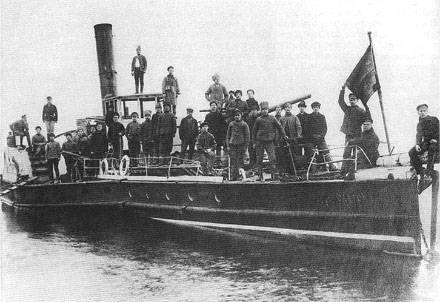 Gunboat "Kakston"
Gunboat "Kakston"Northern Dvina freezing usually occurred between October 15 and November 5. Therefore, the cautious lords of the British Admiralty gave the order to the allied flotilla to go to Archangel in advance.
October 7 allied fleet left the front. Before that, Altham ordered to bring part of the guns with a servant ashore and place them in the Bereznik area.
Encouraged by the departure of the enemy flotilla, the red units attacked the positions of the Allies and, after stubborn four-day battles, occupied the Borki-Gorodok area.
By the beginning of the 1919 navigation, the British had formed on the Northern Dvina a relatively powerful flotilla of special-built ships. Initially, the Allied Flotilla consisted of four river gunboats: “Kokchafer” (“Cockchafer”), “Saikala” (“Cicala”), “Cricket” (“Cricket”) and “Gloworm” (“Glowworm”), as well as two Monitor: M-23 and M-25. All of these vessels went to Arkhangelsk in the fall of 1918 and at the beginning of 1919 appeared on the front, participating in combat operations under the command of Commander Green. In early June, 1919 was joined to the allied flotilla by the Humber (Humber), M-26, M-27, M-31 and M-33 monitors that came from England.
The 23 M-25, M-26 and M-1915 monitors were armed with one 83-mm, one 76-mm and two 37-mm cannons, more powerful monitors M-31 and M-32 - with two 152-mm and one 76-mm guns, and the Humber monitor - two 152 / 50-mm, two 120 / 18-mm guns and four Vickers anti-aircraft guns.
The unarmored gunboats “Kokchafer”, “Saikal”, “Cricket”, “Gloorm” were built in 1915 – 1916. Their speed was 14 units, and weapons - two 152 / 45-mm and two 76-mm guns.
As we see, the British gathered their most modern river vessels on the Northern Dvina.
In 1919, fighting on the Northern Dvina began on May 1, when the gunners "Peacock Vinogradov" and "Karl Liebknecht" under the cover of the floating battery "Moscow" attacked the positions of the British and whites near the village of Kurgomeni.
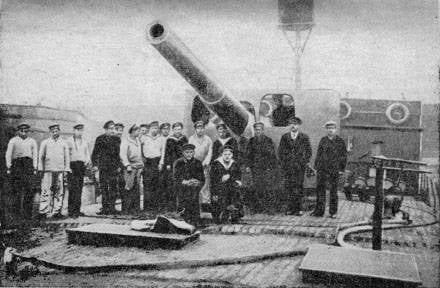 203-mm gun on the floating boat "Moscow"
203-mm gun on the floating boat "Moscow"2 May in the area of hostilities appeared the first Allied ships.
Union aviation daily conducted reconnaissance flights, simultaneously dropping bombs on ships of the Severodvinsk Flotilla. On the night of May 6–7, the Sverdlov mine layer placed a mine fence across the Dvina from the mouth of the Nyuma River to Cape Trinity.
On May 18, the allied flotilla, which included the M-23 and M-25 monitors, the Kokchafer, Saikala, Cricket, Glouorm canoners, and the coastal battery of the Kurgomenskaya position, opened intensive fire on the Red fortifications at Tulgas. Soon the ground forces of the allies also went over to the offensive.
The vessels of the Severodvinsk flotilla opened fire on the allied flotilla and the advancing infantry. The villages of Tulgas, Bor and Trufanovskaya flamed from the fire of the English artillery. Allied infantry knocked out the Reds from the villages of Karpovka, Boltsaya and Trufanovskaya.
By May 22 18 watches, the Red forces completely cleared the Allied fortified position of the Talgas.
19 May, at 5 h. 30 min., The vessels of the Allied flotilla, rising to the bearing structure from Cape Kurgomeni, opened fire on the vessels of the red flotilla, concentrating fire on the floating battery "Moscow" and its tug "Arngold". The canons of "Peacock Vinogradov" and "Karl Liebknecht" went down to the village of Trinity and with their fire they drove away the two Allied gunboats, damaging them and causing a fire on one of them. The Allied flotilla, having gone beyond the range of artillery fire of the gunboats of the Severodvinsk flotilla, maintained an intensive fire on the floating batteries "Moscow" and "Turkestan" and on the red gunners.
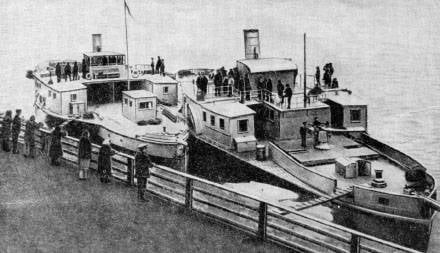 Severodvinsk flotilla ships in Veliky Ustyug before being sent to the 21 front of April 1919.
Severodvinsk flotilla ships in Veliky Ustyug before being sent to the 21 front of April 1919.In 6 h. 15 min. the allies began to fill shells with the floating battery “Moscow” and the tug “Arngold”, breaking the board of the latter with several shells and smashing its right paddle wheel.
The floaters were ordered to retreat up the Dvina to the village of Yakovlevsky, which was done under the guise of the canoners Peacock Vinogradov and Karl Liebknecht.
Seeing the withdrawal of the ships of the Severodvinsk flotilla, the Red Army men abandoned their positions and retreated to the villages of Zaryadye and Yakovlevskoye.
However, the British command, correctly assessing the combat power of the red flotilla, did not decide to move all in and risk their own ships. As a result, further combat operations of both flotillas up to 19 July were in the nature of a positional warfare with almost daily exits of ships to positions and artillery duels at distances close to the limit (taking into account the terrain features). Such duels did not bring any particular success to either side.
In early June, the firepower of the Severodvinsk flotilla was strengthened with a floating battery. On the floating battery "Moscow", they replaced two 120 / 45-mm guns with two 152 / 45-mm guns. In addition, the floating battery No. 6 "Hungary" arrived at the front, equipped with two newest 130 / 55-mm guns.
June 19 coastal and naval artillery of the Allies in 20 hours began a massive shelling of red positions. The next day, at 14, the hours of the Allied ships began to climb up the river. The first to go were the gunboats "Kokchafer" and "Gloorm", followed by the monitors M-27, M-33 and "Humber". However, they soon came under the concentrated fire of the guns of Soviet floating batteries, corrected from a coastal observation point. The English ships were forced to depart.
In 21 h. 40 min. Allied flotilla returned to base. At the same time, four British DH.9 airplanes attacked ships and batteries of the Reds.
One of the 250-pound bombs hit the stern of the floating battery No. 5 "Kansk", causing a fire, which resulted in the detonation of the shells. The team immediately jumped overboard and safely reached the shore. "Kansk" was towed to the shore, and later, when the flotilla departed, the floating battery was blown up from the island of Selets.
Having fallen under the fire of the British ships, the gunboats of the Reds began to retreat. At the same time, they set up a minefield on the island of Selets. In total, 20 people were killed and 10 was wounded during the 23 battle of June on the ships of the Severodvinsk flotilla.
In July, for the Severodvinsk flotilla in Petrograd, 1919-mm guns began to arm two barges for the Severodvinsk flotilla, which were going to be transferred to the Northern Dvina via a system of canals.
On July 8, the red infantry units launched an offensive on the right bank and briefly occupied the village of Selmenga. The reason for the attack was the transition to the red 126 defectors, who reported unrest in the British regiment.
The Red Infantry attacked the Russian white units near the village of Trinity and forced them to retreat into the forest between the Trinity and the Selmenga River. The next morning, the Whites and the British launched a joint attack, and the Reds had to leave their positions and retreat to the far bank of the Selmenga.
According to Soviet sources, “during the battle with our flotilla, the M-33 monitor was hit by a heavy projectile, and the canoe ship“ Cricket ”was hit at the waterline and forced to descend down the river and moor at the barge-workshop to escape from flooding. Due to long firing at high elevation angles, the artillery failed on the cannon “Saykal”. The position of the British was critical, due to the non-arrival of reinforcements of the ground forces, and only four times the shelling of our flotilla and our location with monitors, with the assistance of aviation and especially the 6-inch artillery of the British canlues "Gumber", allowed the enemy to repel all our attacks. "
On July 14, during the next Allied air raid, an English Fayri-IIIV seaplane was shot down from a Nekrasov messenger ship. The plane landed on the water, and its crew - the pilot Marshall and the observer Laxdoun - fled into the forest. Later, they were given to the Red Army local peasants.
In early August, the Allies launched a new offensive on the left bank of the Dvina - along the river Nyuma and forest glades on the village of Chudinovo, and on the right bank on the village of Gorodok.
The British ships actively supported the offensive of the Allied ground forces. Monitors M-27, M-31, M-33, Humber and gun Saikala participated in the battle. And when detachments of Reds appeared on the banks of the river, English speedboats immediately flew up and opened machine-gun fire.
The British discovered and destroyed a large minefield from the “Rybka” mines between the port of Seltso and the village of Nizhnee Seltso. At the same time, an English motorboat exploded in a mine.
Another 15 mines "Rybka" Reds were allowed downstream to meet the British. However, they caught all the 15 mines, loaded them into carts and set up near the village of Nizhny Lipovets in the rear of the red flotilla. The Reds themselves put 8 ball mines above Puchuga with fear.
During the battle of 10 in August, 6 killed and 9 injured turned out to be on the ships of the Reds.
The massive use of mines and long-range artillery on the Northern Dvina, as well as the absence of railways and highways, which excluded a deep bypass of coastal positions, created a stalemate.
The outcome of the war on Northern Dvina was decided by politicians on Downing Street 10. On January 10, 1919, the British Prime Minister Lloyd George, at a meeting of the Allies in Paris, said: “The situation in Russia is very bad; it is not known who has the upper hand, but the hope that the Bolshevik government will fall has not been justified. There is even a message that the Bolsheviks are now stronger than ever, that their internal situation is strong, that their influence on the people is now stronger ... The idea of destroying Bolshevism by military force is insane ... A military campaign against the Bolsheviks would have made England Bolshevik and bring London to the Council. ”
Already on September 4, the personnel of the Slavic-British Air Corps was loaded onto a ship going to England. The British pilots remained there, and the majority of the Russian pilots went farther to the Black Sea to General Denikin.
September 4 red land units launched an offensive. The vessels of the Severodvinsk flotilla were to provide them with fire support. However, for this it was necessary to overcome several of its own and English minefields on the Northern Dvina. His first barrage was at the village of Borisov and Petropavlovsk rolling. Almost the entire mine detachment of the Severodvinsk flotilla went there. At the time, there were more than ten minesweepers in the flotilla, and by the end of the year there were 17, taking into account wheeled tugs, distilled from the Upper Volga.
The trawling at the village of Borisovskoye and the Petropavlovsk Rollover went very badly. During the day, 4 September managed to clear only two mines. In order to speed up the sweeping operations, it was decided to limit the penetration of the passage without removing the entire minefield. On September 6, the passage at the village of Borisovskoye and the Petropavlovsk rolling was plowed through, and the minesweepers set about removing the minefield put up by the allies at the village of Puchuga.
September 22 Severodvinsk flotilla approached the village of Seltso. By this time, the red units occupied the village of Bereznik in 14 versts below the mouth of the Vaga. In the headquarters of the Severodvinsk flotilla there was information about the use by the allies of a "mine of a special system that exploded under the action of iron on a magnetic surf in a mine." To verify this information, 22 in September in the area of the village of Nizhnee Seltso, the mine sweeper, who had an iron hull, was launched at the place of the supposed minefield near the village of Seletskaya. Minesweeper safely passed through the alleged mines near the village of Ples and returned. Therefore, the command of the Severodvinsk flotilla decided that the rumors about the mines of a special system were “just a provocation”. In addition, it was known in red that the British, along with magnetic mines, also used conventional sea-type ball mines, and such a barrier was found near the village of Ples. This further convinced the Red Command of the falsity of rumors about "special" mines.
To speed up the sweeping operations, the command of the Severodvinsk flotilla was allocated by a special detachment of 150 people who, under the guidance of the miners, surveyed the fairway using an ordinary cable towed by boats or wind up like a fishery net from the shore. In this way, we managed to pull ashore contact mines up to 30.
On September 23, in the area of the proposed minefield, the Soviet minesweeper Belogor was killed by an unusually strong explosion, which was a complete surprise for the Red Command. The authorities decided that the day before the fairway was thoroughly examined by the minesweepers, the explosion occurred from a finely set ball mine, and ordered the sweep to continue.
The next day, not far from the place of Belogor’s death, the minesweeper Messenger was killed by an explosion and sustained damage to Udachny. This forced the flotilla command to abandon the ship’s wire before the final survey of the fairway with the help of divers, which further aggravated the situation at the front.
On the Northern Dvina, the British for the first time in stories Wars applied their top secret magnetic mines. The mine body consisted of the lower cylindrical and upper conical parts. It was made not of steel, like a contact mine, but of concrete. The bottom diameter of the mine was 762 mm, the top diameter of 528 mm, the height of the mine 794 mm. Such dimensions allowed the divers are relatively easy to detect at the bottom. The total weight of the mine was 713 kg. Mine charge - 360 kg of TNT in a rubber bag. All the metal parts of the mines were made of copper. The British put mines from a wooden barge using a crane, the capacity of the barge is 20 min. Towed a barge boat with a wooden hull. Depth setting reached 25 – 30 m. Usually mines were put in a checkerboard pattern.
Since the land command constantly demanded artillery support from the courts, the command of the Severodvinsk flotilla came up with an original way out - it was decided to turn the Red Army men and sailors into ... barge haulers. Since the floating batteries had a relatively small draft, the “barge haulers” could drag them to fairly shallow places along the coast, where, according to the assumption of red, magnetic mines should not have been. September 29 divers off the island of Selets for the first time removed a magnetic mine.
7 October, it was decided to lower the floating batteries downstream. However, the posting of barges "barge haulers" was too slow. People were not used to such work, and most likely they simply sabotaged. Then the command spat on the mines, and the 10 and 1 floating boats 4 in October in the search of the Perebor and Threshold minesweepers passed the area of the alleged magnetic barrier and in October 13 arrived at the village of Kollezhskaya (Pochtovoye) without any problems.
So, it was the Soviet river flotilla that frustrated the plans of the interventionists and the White Guards to capture Kotlas and Vologda and join up with the Kolchak front. Well, in September 1919, the flotilla went over to the offensive, which led to the defeat and flight of the whites.
Although in the autumn of 1919, the minesweepers of the Severodvinsk flotilla mined 112 mines, the Northern Dvina trawling was completed only in the navigation of the 1921 of the year. Particularly difficult was the trawling of magnetic mines. In the summer of 1920, two English magnetic mines were raised by divers and dismantled on the shore. The best specialists of the Soviet Republic headed by V. Ya. Pavlinov, the former 1 captain, were attracted to study them. They constructed several magnetic trawls, but all these designs were unsuccessful.
Alas, history does not teach us! During the events of summer - autumn 1941, Soviet sailors "suddenly met with a new unknown German weapon - magnetic mines."
Information